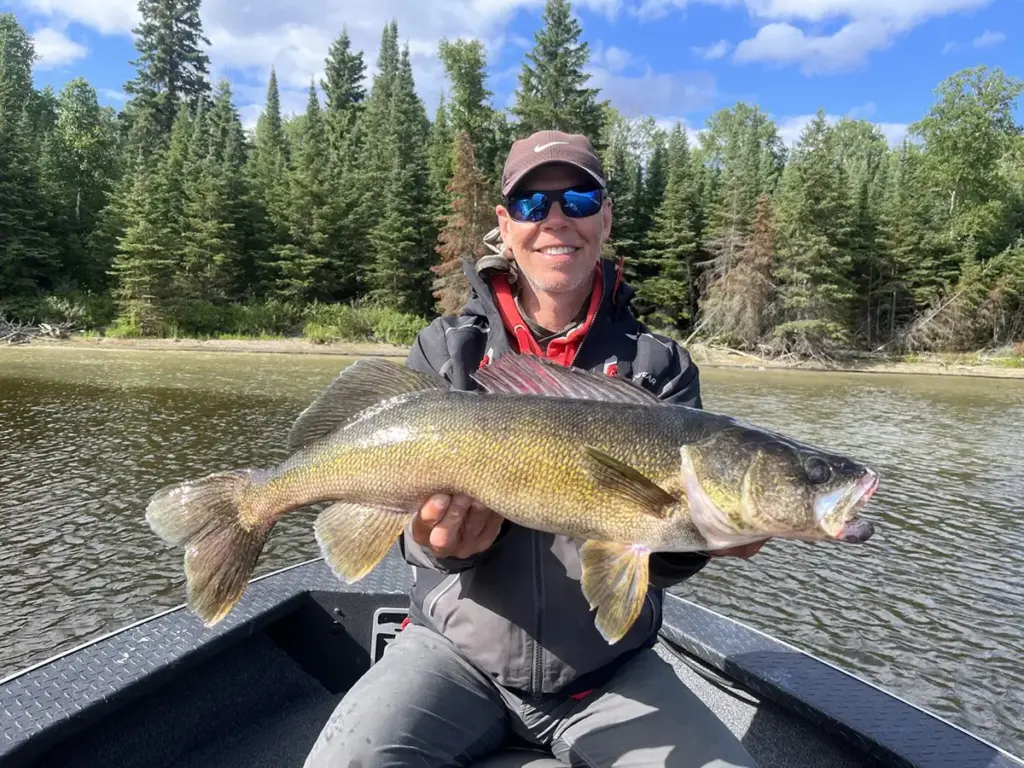This weekly fishing report needs to be delivered in two parts. As with most major changes to our fishing patterns, this one revolved around a dramatic change in weather. July 4 was the turning point in the week. That was the day that endless sunny, flat, hot, and calm turned into windy, stormy, choppy, and cool. At the beginning of the week, we were swimming at lunch and talking about air conditioners and by the end of the week, we were adding layers, closing the lodge windows at night, and thinking about wearing a toque off the dock.
And the fish moved!
Walleyes:
At the beginning of the week, it was not exactly a weed bite, but it felt like there was a pretty consistent pattern across the lake. The walleyes were not super shallow, but the main lake deep patterns were vacant. As a continuation from the previous week’s report, we were fishing walleyes in 10 – 16 ft. of water and we were moving fast with plastics. Both volume and size could be consistently found in that band of the water column and not surprisingly, that zone was filled with clouds and clouds of bait. There was a small amount of variation between guide boats. Some were on 3/8 oz. jigs and some were on 1/2s. Some were at 1.0 mph and some felt like they were doing better at 1.5 mph. The guide crew likes to debate and discuss, but it was all some version of moving at speed with bigger jigs and Gulp to target active and scattered walleyes.
All of that changed on July 4. Storm clouds came in, it rained and hailed, the wind blew, and then it got cold. And the walleyes went everywhere. Guides still found some very good bites, but they were very different than the previous week. And for every guide that found a new good bite, there were several others that tried multiple different experiments that failed. When dozens of great bites shut down, we did what we always do; and we started the experiments over again. Just as many guides located walleyes in 20 – 25 ft. and targeted them with light jigs and minnows as guides that stuck with big jigs and plastics and just covered more water. Both worked, but they didn’t work as well as they did the first half of the week.
Even though the volume and consistency took a nose-dive, there were still some really big walleyes caught in the second half of the week. One 30 was caught from 7 ft., another 30 was caught from 15, and a 29 was caught from 32 ft. of water. Those were the big fish. Volume changed dramatically as well.
For the week, we caught and released 46 walleyes over 27 in., including 6 – 28s, 4 – 29s, 2 – 30s, and 1 over 31. Volume averaged 30 over 18 in. per boat per day. Many boats had way more.
Northern Pike:
Casting for pike was a crap shoot.
Some days were awesome and some days sucked. And they were back-to-back.
For the week, we caught and released 14 over 37 in., including 2 – 39s, 1 – 40, and 1 – 42. Spoons and blades worked best. The cabbage weeds are topped out and are the key to big pike. Some weed beds from previous seasons have failed.
Production for big Pike also took a major hit after July 4. We still caught a few, but it was night and day. The bite was off. There was a slight recovery today. I am not saying that I would go casting all afternoon, but it was very much better than yesterday.
The Take away:
Weather changes can sneak up on us….
The SWWL guide staff are not only watching for those changes, but they also know that they will have a plan to find the next solution.

